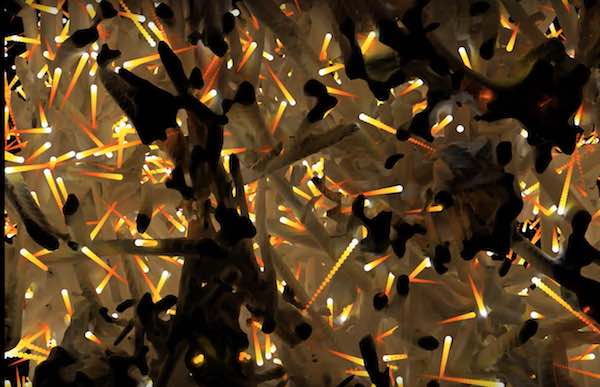
[Image above] Credit: Berkeley Lab; YouTube
Forget science.
Researchers at Berkeley Lab and NASA are creating mesmerizing movies.
Credit: Berkeley Lab; YouTube
Okay, I lied—that mesmerizing video is very much science.
It represents a 3-D simulation of high-energy particles bombarding a carbon fiber fabric. And the bombardment you see in the video represents only what the material experiences in the span of a mere 0.002 second.
So while it’s mesmerizingly beautiful, that animation depicts the incredible onslaught that advanced materials must withstand in extreme environments—such as those encountered by engineered objects hurtling through space and planetary atmospheres.
The Berkeley Lab and NASA researchers are modeling the microscale details of how materials respond to atmospheric entry conditions in an effort to help develop new materials for such extreme environments, including materials to build better heatshields for spacecraft.
That’s because the classic ceramic tile heatshields that have worked for many previous space missions just won’t cut it as space travel continues to evolve—future spacecraft will need to carry larger payloads, including humans, to survive longer distances and greater time in space.
One promising option for future spacecraft is flexible heatshields, which have many benefits over hard ceramic tiles—flexible shields are lightweight, saving precious poundage (every pound sent into space costs thousands of dollars), and can fold up when not in use, saving previous space. And although flexibility and strength often come at the expense of one another, we know that doesn’t have to be the case.
To that end, the movie-making scientists at Berkeley Lab and NASA are using X-rays from Berkeley’s Advanced Light Source (ALS) synchrotron to build a better model of the microscale behavior of potential spacecraft-protecting materials.
“We are developing a system at the ALS that can simulate all material loads and stresses over the course of the atmospheric entry process,” Harold Barnard, a scientist at Berkeley Lab leading the X-ray work with NASA, says in a Berkeley lab press release.
While scientists have been able to simulate atmospheric entry and extreme conditions in the past, those methods have never afforded an adequately up-close look at the materials to illuminate their structure and strength properties.
In the new technique, Berkeley and NASA scientists used X-ray microtomography to image small samples of a material from all angles. Then, they used computational techniques to meld those individual images into 3-D models.
For example, the team investigated samples of phenolic impregnated carbon ablator (PICA), a carbon-fiber-based heatshield material that’s already used in space missions. For instance, PICA protected the spacecraft that landed the Curiosity rover on Mars.
“Before this collaboration, we didn’t understand what was happening at the microscale. We didn’t have a way to test it,” Barnhard says in the release. “X-rays gave us a way to peak inside the material and get a view we didn’t have before. With this understanding, we will be able to design new materials with properties tailored to a certain mission.”
That means that new materials can be tested more accurately, in less time, and at lower cost, affording the ability to consider more materials and ultimately identify materials that are best suited for a specific purpose.
Using data the scientists gathered from X-ray microtomography experiments on PICA, they developed software that can glean those X-ray results to reveal important insight about a material’s properties. The software, called Porous Materials Analysis (PuMA), can use experimental data to predict a material’s porosity, how it conducts heat, and its decomposition during atmospheric entry.
Watch the mesmerizing visualization of that research:
Credit: Berkeley Lab; YouTube
But ultimately, developing such tools to predict how a material responds to these extreme otherworldly conditions has applications beyond space exploration—the same tools can be used to test a wider array of high-performance materials.
“The ultimate objective of the collaboration is to establish a suite of tools that includes X-ray imaging and small laboratory experiments, computer-based analysis and simulation tools, as well as large-scale high-heat and wind-tunnel tests,” according to the release. “These allow for the rapid development of new materials with established performance and reliability.”
So, to infinity—and beyond.
